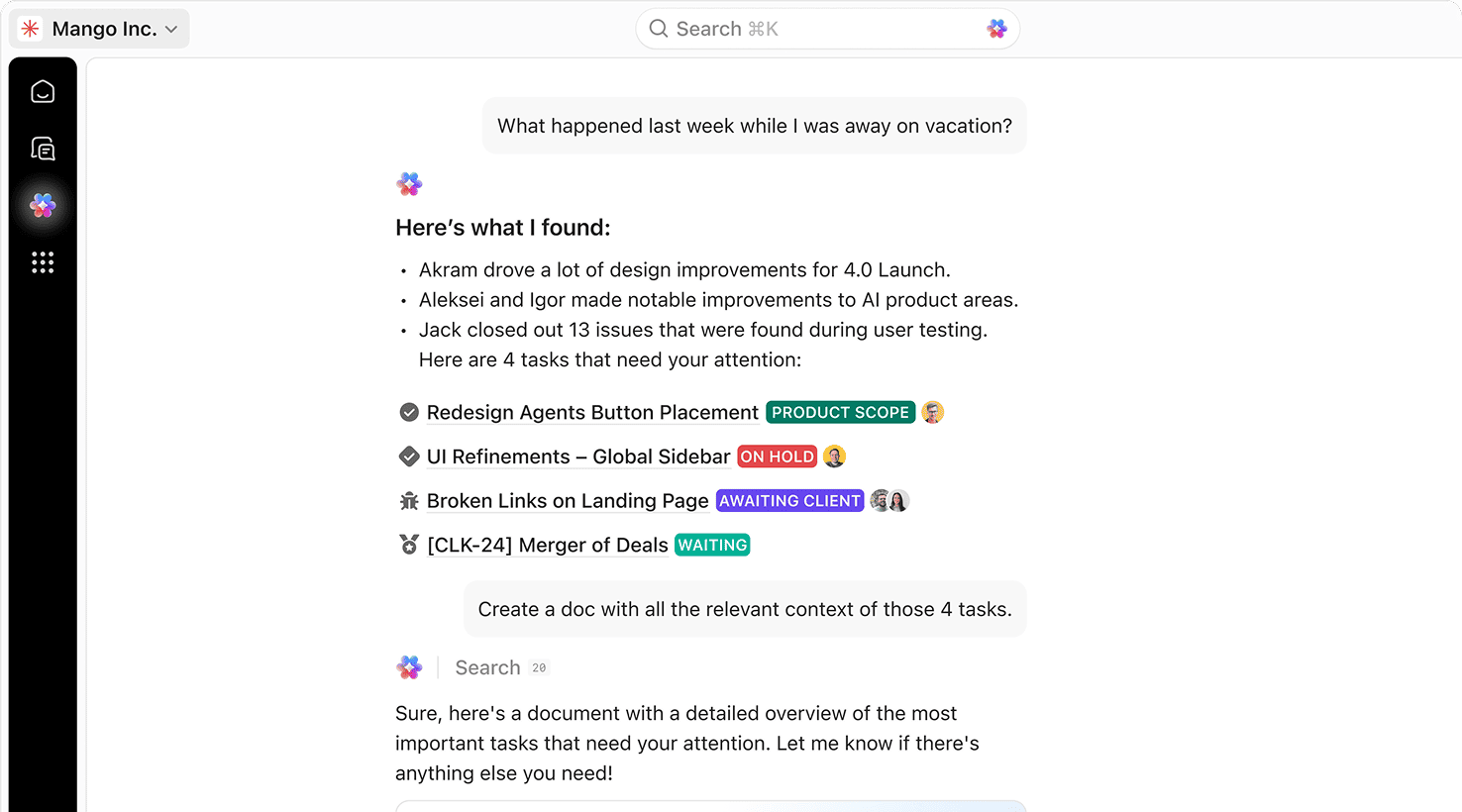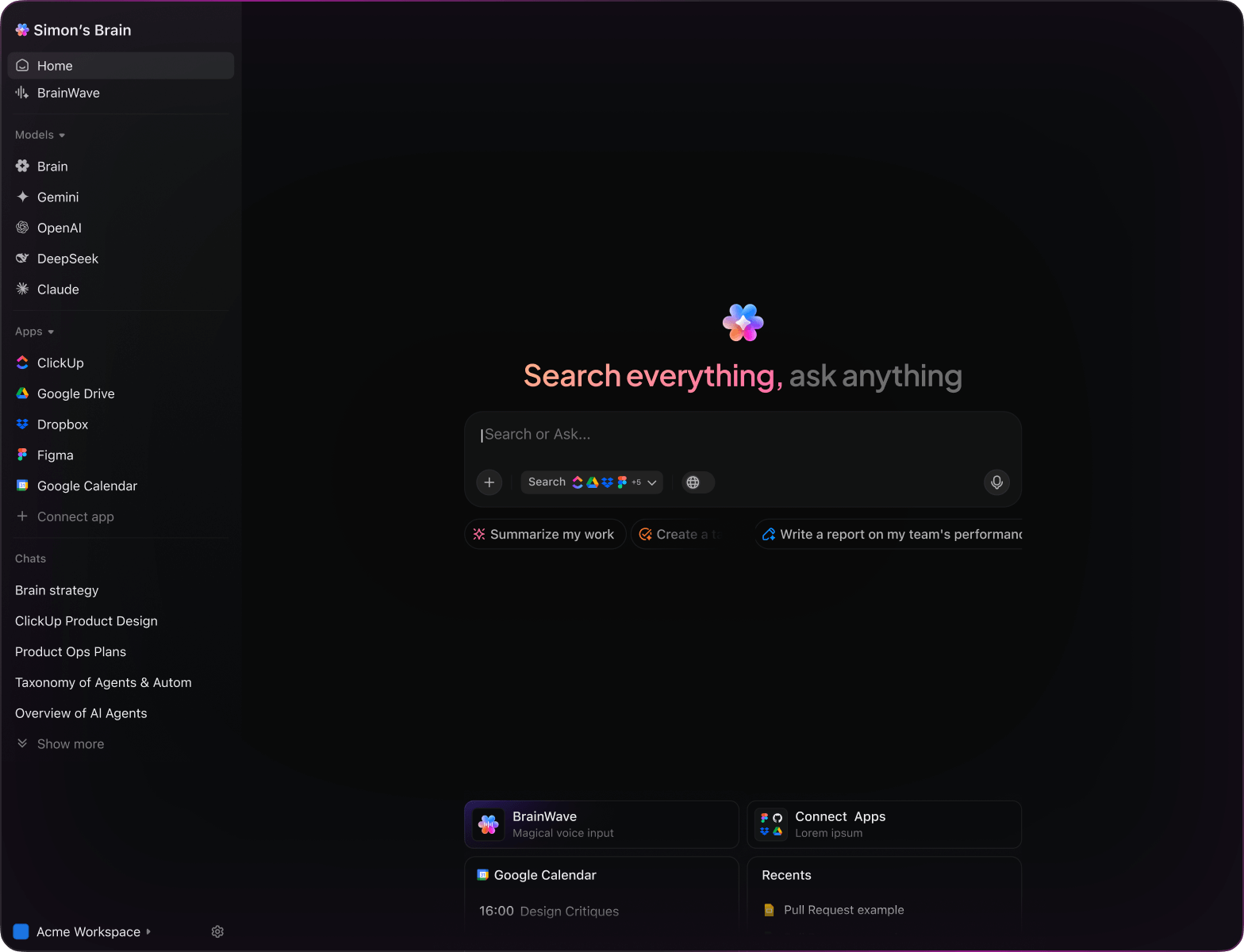AI Product Roadmap Generator
Mastering the AI Product Roadmap Generator
Explore how AI streamlines product roadmap creation—from aligning features to setting priorities. Tools like ClickUp Brain empower you to design clear, actionable plans in moments.

Trusted by the world’s leading businesses
AI for Product Roadmaps
Understanding the AI Product Roadmap Generator
An AI Product Roadmap Generator automates the creation and updating of product roadmaps—those strategic blueprints guiding development teams and stakeholders. Traditionally, crafting these roadmaps required manual input in spreadsheets or presentation tools, frequent revisions, and risked misalignment.
AI transforms this process. With intuitive natural language commands and real-time data integration, these generators help you instantly visualize feature timelines, dependencies, and priorities. Simply prompt: “Build a product roadmap for our next AI feature releases with milestones and deadlines,” and AI constructs a comprehensive plan.
Integrated with project management platforms like ClickUp Brain, it turns static roadmaps into dynamic, collaborative documents that evolve alongside your product lifecycle.
ClickUp Brain vs Traditional Tools
Why ClickUp Brain Stands Out for AI Product Roadmaps
ClickUp Brain is embedded, context-aware, and execution-ready—less setup, more impact.
Conventional Roadmap Tools
- Isolated: Roadmaps exist separately, requiring manual updates and external sharing.
- Static visuals: Often PDFs or slides that get outdated quickly.
- Manual maintenance: Every change demands time-consuming edits.
- Limited collaboration: Difficult for teams to work simultaneously.
- Data silos: Lacks integration with real project data or team workflows.
ClickUp Brain
- Seamless integration: Roadmaps live within your ClickUp workspace, linked to tasks and docs.
- Real-time collaboration: Teams edit and comment together instantly.
- Auto-updating: Roadmaps sync with changing project statuses and priorities.
- Robust security: Follows ClickUp’s permission and access controls.
- Brain Max capabilities: Customize logic and AI-driven insights for smarter roadmap planning.
Step-by-Step Process
Generating an AI-Driven Product Roadmap
Create a smarter, adaptive roadmap with this straightforward approach.
1. Gather Data from Your Workflow
Conventional approach: Manually compile feature requests, deadlines, and dependencies from various documents.
With ClickUp Brain:
ClickUp automatically pulls relevant tasks, goals, and deadlines, creating a draft roadmap based on your live project data. Simply ask: “Show me the roadmap for Q3 AI product launches.”
2. Let AI Prioritize and Sequence Features
Conventional approach: Prioritization is often subjective and time-consuming.
With ClickUp Brain:
AI analyzes dependencies, resource availability, and impact to suggest optimal sequencing and priorities, reflecting real-world constraints and team capacity.
3. Customize Your Roadmap Layout
Conventional approach: Static Gantt charts or lists that limit visualization.
With ClickUp Brain:
Use drag-and-drop boards, timelines, or mind maps to tailor your roadmap’s presentation. Brain offers smart grouping suggestions, like clustering AI features by development phase or customer segment.
4. Keep Your Roadmap Live and Adaptive
Conventional approach: Roadmaps quickly become outdated as plans shift.
With ClickUp Brain:
Your roadmap auto-updates with project progress, changing priorities, or team feedback, ensuring your plan stays relevant and actionable without manual edits.
Elevate Roadmap Planning with AI
Stop juggling spreadsheets—build adaptive, connected product roadmaps in seconds using ClickUp Brain.






Use Cases
3 Strategic Use Cases for AI Product Roadmap Generators
AI-powered roadmaps bring clarity and agility to product teams. Here's how industry leaders leverage them.
Use Case 1
Accelerated Feature Prioritization for Agile Teams
Product managers rely on AI roadmaps to rapidly assess feature value, dependencies, and resource allocation—speeding decision-making and aligning with sprint goals.
This live prioritization model keeps teams focused on delivering maximum impact with minimal delay.

Use Case 2
Seamless Cross-Functional Alignment
AI roadmaps enable product, engineering, and marketing to visualize shared goals and timelines, reducing miscommunication and facilitating smoother launches.
Teams can simulate different scenarios, ensuring everyone stays in sync from ideation to release.

Use Case 3
Dynamic Roadmap Adjustments Amid Market Changes
Product leaders use AI-driven insights to pivot quickly in response to user feedback or competitive shifts.
Instantly update priorities and timelines without disrupting team workflows or losing strategic visibility.

Key Features of AI Product Roadmap Generators
What Defines an Exceptional AI Product Roadmap Generator?
Discover the six core capabilities that make AI roadmap tools indispensable.
Conversational Roadmap Creation
Translate plain language inputs into structured, actionable roadmaps instantly.
Real-Time Data Integration
Automatically syncs with project updates to keep your roadmap current.
End-to-End Workflow Connection
Links roadmaps with tasks, timelines, and documentation seamlessly.
Flexible Visualization Options
Supports Gantt charts, Kanban boards, and mind maps for diverse planning styles.
Intelligent Dependency Mapping
Detects and visualizes feature interdependencies and resource constraints.
Collaborative Editing and Feedback
Enables teams to co-create, comment, and iterate in real time.
Transform Your Product Planning
Design, refine, and adapt product roadmaps effortlessly—AI handles complexity so you drive outcomes.






FAQs